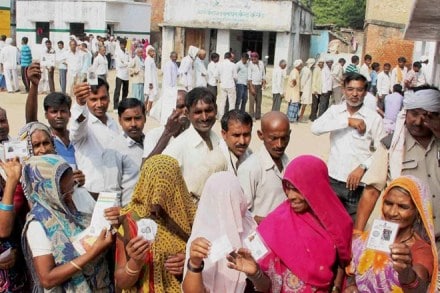Irrespective of the several communities, the turnout for the first phase polls of 73 seats in Uttar Pradesh Assembly Elections 2017 saw a significant rise on Saturday. According to IE, in comparison to the last state assembly elections in 2012, the turnout was reported to be higher in 15 of the 17 Muslim dominated regions, 11 of the 12 reserved seats and 9 of the 11 Jat strongholds. All in all, the total turnout was reportedly 64.22%, which is 3% more than that of 61% of 2012. Now, both Akhilesh and Rahul Gandhi claimed to have swept the state of its foot in the first phase, as did BSP and the BJP.
Let us take a closer look at the communities/regions, that saw a steep rise in the turnout and find out for ourselves about which party might be right in their claims:
Muslim Dominated regions:
In 2012, the SP had won 6 seats in 17 constituencies where the Muslim population was 40% or more. The BJP and the BSP had won 5 each, while the Congress had managed just one. These are the regions, where every party grapples for the Muslim votes as the BJP traditionally remains content with the division of votes between the others. The highest turnout was recorded in Muzaffarnagar(2013 riots), with nearly an 8% increase from the 56% in 2012 to 64% in 2017. However, local politicians interpret that the higher turnout did not mean that it was more Muslims casting the votes. Speaking to IE, one of the RLD leaders claimed that the Western UP Muslims always cast their votes, and hence if the turnout seems increased it must have been more Hindus had gone out to cast their votes. And if we remember the sentiments shown by Muslims of Bareilly, who had opposed to being used as a community to vote out the BJP, it seems that the BJP might have just skipped ahead of the others. But again, it is all speculation in the air until March 11.
Meanwhile, take Muzaffarnagar, Budhana and Shamli out of the equation and we still see a steep rise in voter turnouts in Bulandhshar (5.94%), Koil (5.3%), Kithore(4.34%) and Kairana(3.36%). Kairana is BJP MP Hukum Singh’s “region”. He had won the assembly seat in 2012 before winning the Lok Sabha seat from the same region. In 2016, he had raised voices against the alleged “exodus” of Hindus from the region; something that had been highlighted by the likes of Yogi Adityanath among others.
Reserved seats:
There are 12 reserved seats among the 73 seats that went for elections in the first phase on Saturday. The BSP had won 5 in 2012, while 3 were won by the RLD. The Congress and SP had shared 2 seats each. The BJP did not manage to win anything last time around and it is very unlikely that it will be doing any better this time. These seats have been a stronghold of the Bahujan Samaj Party and Mayawati has kept her best cards close to her chest. The Agra Cantonment saw an increased in turnout by 12.56% from 2012. The seat is currently held by the BSP, despite its mixed population of Thakurs and Vaishyas. Although, reports suggest that the SCs are the dominant force in the region.
Also watch:
[jwplayer DQjHBLd4-DE6UeepY]
Jat Strongholds:
The RLD is a force to be reckoned with in these 11 states dominated by the Jat community. In 2012, the RLD had won 5, while the SP and BSP had shared 3 each. And if the turnout was recorded to be higher in these 11 seats, the BJP and the RLD definitely have the rights to stake claims to these votes. Chharprauli, part of the Baghpat Lok Sabha constituency had seen RLD chief Ajit Singh winning almost 2 lakh votes in 2014 amidst the Modi wave. The seat saw the steepest turnout of all the 73 seats that went to polls on Saturday with a rise of 12.7 percentage points.
BJP’s fortress
These include the 11 seats that BJP had won in 2012, 5 of them being Muslim dominated areas. The turnout was reported to have a rise in 8 of these constituencies, except for 3. The 3 being, Sardhana, Meerut and Firozabad which saw a decrease between 1 and 2.5 % points. BJP’s Sangeet Singh is the MLA in Sardhana, a deep pool of Thakur and Muslim votes. Incidentally, Singh has also been named in a case relating to Muzaffarnagar riots.
So, we will still have to wait and watch here but it is most likely that most of the regions traditionally dominated by certain political parties will continue their loyalties. This is, however, a democracy and people change. Meanwhile, sitting at a desk in Delhi, it looks like every party’s claim of sweeping away the first phase is a nothing more than a stunt. While most of these parties have their forts in certain regions and claim them to be impregnable, this is a democracy and people change as their opinion do and so do their votes.
